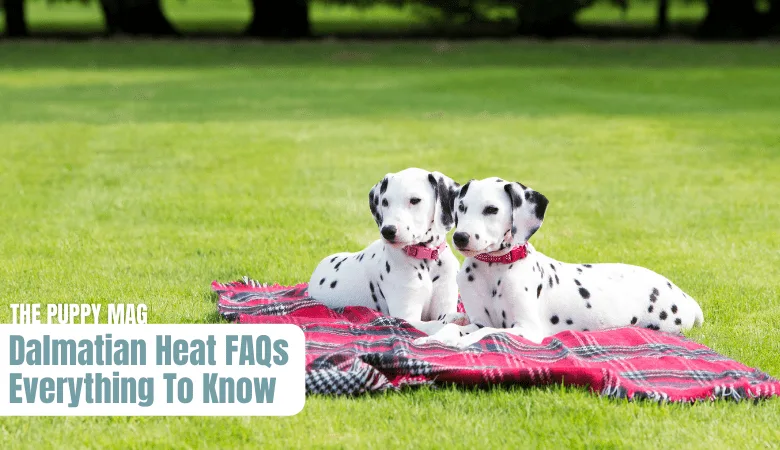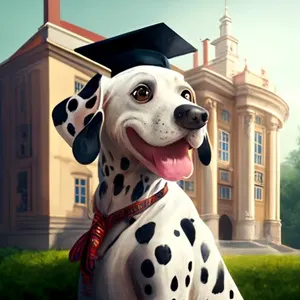Knowing when your Dalmatian will go into heat isn’t straightforward, yet it is fairly important! We know there are many questions surrounding this topic, so in this article, we’ll cover absolutely everything you need to know about Dalmatians and their heat cycles.
Most Dalmatians go into heat between 6-10 months. But keep in mind, a Dalmatian may go into heat before or after this time frame as it varies significantly for every Dalmatian.

When Do Dalmatians Go Into Their First Heat?
As explained above, it’s usually between 6-10 months when most Dalmatians will enter their first heat cycle.
But it’s crucial to keep in mind that every Dalmatian is different and this time frame is not set in stone.
We’ve had reports of some Dalmatians entering heat as young as 5 months, and others as late as 18 months old. While this is rare, it does still happen and doesn’t usually mean anything is wrong.
If your Dal hasn’t entered into heat by 12 months, it’s wise to schedule a vet check-up just to ensure everything is okay.
How Long Do Dalmatians Stay In Heat?
Dalmatians remain in heat for around 3 weeks, give or take a couple of days. The two most notable stages of the heat cycle (proestrus and estrus) last between 7-10 days each.
Again, this is just a guideline and every dalmatian can be a little different. You’ll be able to see when your Dalmatian’s heat is over with the signs I’ll run through below.

Psst. A quick update on Dalmatian training! Brain Training For Dogs could be the best training approach we’ve seen for Dal pups. Results show improvement in obedience and behavior quicker than we thought possible! Check it out.
How Often Do Dalmatians Go Into Heat?
Dalmatians have about TWO heat cycles per year (once every 6 months). However, it can take a few heat cycles in the beginning to regulate an established pattern.
It’s true that smaller dogs go into heat much more often than larger dogs. Some small breeds may go into heat up to three times per year. Rest assured, it won’t be this often for your Dalmatian!
Signs That Indicate Your Dalmatian Is Going Into Heat
So how do you know when your Dalmatian is entering into heat? This is one of the main concerns regarding this topic, so let’s clear that up below.
Early signs indicating your Dalmatian will go into heat:
- Changes in behavior (needy, distant, irritable)
- Swollen vulva
- Tail tucking
- Discharge
- Blood spots
- Licking the genital area
- Change in energy (more lethargic)
While there are other signs that come when your Dalmatian is actually in heat, these are typically the initial signs you’ll notice early. Please note, it’s likely you will not see all of these signs at the same time so it’s important to be on the lookout for any of them.
Popular read: Do Dalmatians Shed? (Tips to Know)
Dalmatian Heat Cycle Stages
There are four stages to your Dalmatian’s heat cycle, and each one means something different. Let’s explain those below.
1. Proestrus
The very first stage is called Proestrus, which is essentially the preparation stage. Many changes will start to happen and the first signs of a swollen vulva, blood spots, and a change in behavior are likely.
Please note: during this stage which lasts 7-10 days, your Dalmatian will NOT be fertile and will not accept a male, despite attracting them with a release of hormones and smells. Interactions with other dogs during this stage can result in nasty fights.
Signs of Proestrus:
- Change in behavior
- Swollen vulva
- Blood spots
- Discharge
- Genital licking
- Tail tucking
- Aggression towards other male dogs
2. Estrus
The second stage is called Estrus. This is when your Dalmatian is fertile and ready to mate. During these 7-10 days she will be accepting of most intact males and may even take it upon herself to seek a mating partner (more on this later).
During this stage, she may become more aggressive towards other female dogs.
Signs of Estrus:
- Swollen vulva
- Frequent urination
- Presenting vulva (tail to the side)
- Flirtatious behavior
- Accepting of male dogs
- Slowing of discharge and bleeding
- Heightened aggression towards female dogs
3. Diestrus
The third stage is called Diestrus. This is the stage whereby your Dalmatian’s body slowly returns back to normal, and this takes around another 7-10 days.
If your Dalmatian has been impregnated during Estrus, her body will remain in Diestrus throughout the 60-70 day pregnancy.
Signs of Diestrus:
- Vulva returns to normal size
- Behavior starts stabilizing
- Bleeding or discharge stops
4. Anestrus
The last stage is known as the resting stage. Your Dalmatian’s body remains in Anestrus until she enters her next Proestrus whenever her next heat cycle comes around.
Trending article: When Do Dalmatians Stop Growing (How Big Do They Get?)
How To Care For a Dalmatian In Heat?
One thing many owners worry about is caring for their Dalmatian in heat…
What do you need to do? Do you even need to do anything? How can you make her feel more comfortable? These are great questions so let’s explain everything below.
1. Be ready for behavior and temperament changes
One of the first things owners should prepare themselves for is quick changes in behavior and temperament. We’re talking unexplained mood swings and big deviations from how your Dalmatian usually acts with you.
We must accept these changes in behavior and not react negatively. Her body is experiencing weird and unfamiliar feelings, and she will act different (that’s normal!)
While this can be quite unsettling to see such a dramatic change in behavior, it’s important to know it’s normal and only temporary.
We mustn’t freak out and react differently or weirdly towards our Dals. At this time, they will need our consistency and support, even if they are acting unusual.
2. Supervision outside is crucial
Right from Proestrus, her body will be releasing hormones that male dogs will smell from a mile away. While she won’t want anything to do with other dogs, males will still try accessing her. This can lead to devastating fights.
Supervision is advised, even when letting her outside in your own yard. When it comes to exercise, many owners prefer to keep their Dal at home for a few weeks and exercise them there. In my opinion, this is the safest way to do things.
Although exercise remains crucial, taking a Dalmatian to the dog park during heat is a seriously risky move. Either a fight can break out, or she can be impregnated quickly. (you would be surprised how quickly this can happen).
3. Use a leash when in public
If you do decide to take her outside in a public area while she in heat, never let her off the leash.
If she is in the Estrus stage, she could take it upon herself to run off and seek a male. This has happened so many times before and leaves owners helpless. Sometimes, they haven’t been able to find their dogs again.
This only adds to the fact that it’s probably best to keep her at home for the whole duration.
4. Extra cleaning will be necessary
Gather plenty of old towels and stock up on dog-friendly pet cleaning products, as it can get quite messy. Some Dalmatians only experience a slight discharge and bleeding, whereas others, can experience a lot.
Some owners limit their Dalmatian’s movement for a few weeks, to keep the mess confined and controllable, which I think is a good idea.
Be sure to frequently clean her bed and floors where she resides. It’s crucial to keep on top of this as the bacteria can build up and become unhygienic quickly.
5. Diapers (consider them)
Doggy diapers are a thing, and some dogs actually do not mind them. If your Dalmatian accepts wearing one, you’ve hit the jackpot.
These diapers will soak up all discharge and blood and prevent a lot of mess in the process. Be sure to replace them daily. Most dogs will refuse to wear one, but it’s definitely worth a try.
6. Monitor her eating habits
Changes in appetite are usual throughout heat cycles, but it’s important we try to avoid food refusal where we can.
Be ready to tackle food refusal…
You can try wetting her kibble, adding a little unsalted meat broth, or even mixing in a little wet dog food to provide a boost in flavor.
Whatever it is, try to keep the change healthy and minimal, but just enough to keep her eating. Hopefully, this won’t be necessary with your Dalmatian.
7. Consider a post-heat vet check-up
While not mandatory, it can be a good idea to follow up on her first heat with a health check. While nothing usually ever happens, there are some known health complications that can happen after a dog’s first heat cycle.
Once again, this is very rare and a check-up isn’t usually necessary, but it’s worth knowing. And remember, you can schedule a check-up with your vet for any reason (don’t feel like there has to be something wrong in order to make an appointment).
Should You Spay Before Or After First Heat?
If you are interested in spaying your Dalmatian, the big question is when should you do it? Before, or after their first heat?
This is highly debated, and unfortunately, many veterinarians do not see eye to eye on this topic, making it harder for us to know what to do.
While some evidence shows that there’s an increased chance of mammary tumors when spayed before the first heat, other evidence shows that spaying before increases lifespan and reduces the chances of other health issues down the line…
Ultimately, the best thing to do is consult your veterinarian about this and have them run a full and detailed health scan before. This could shed light on a more correct and obvious answer, depending on your Dalmatian’s current state of health.
One thing I would say is that if you do want to spay before her first heat, try not to have it done unnecessarily early. The longer we wait, the more estrogen and hormones her body will be able to produce before this procedure ultimately stops that.
Letting her body develop her estrogen levels and experience these hormones, will result in greater maturity and could impact her behavior and temperament positively.
It’s hard to know what to do, so I would advise consulting your vet for a tailored answer.
Is There Anything Else To Know?
Ultimately, this is a natural process, and there isn’t too much we can do other than to be ready and supportive of all these new changes. Remember, the entire process usually only lasts 3 weeks (give or take a few days).
Understand the risks of interactions with other dogs and be sensible if you decide to take your Dalmatian out in public for exercise purposes.
Other than this, there isn’t much more to know! Your Dalmatian will come out the other side more mature, calmer, and well-rounded.
Thanks for reading! Back to more Dalmatian articles.
Resources:
- https://www.britannica.com/animal/dog/Reproductive-cycle
- https://vcahospitals.com/know-your-pet/estrus-cycles-in-dogs
- https://pets.webmd.com/dogs/how-tell-if-dogs-heat
